There are myriad reasons why the Buffalo Sabres are outside of the playoff picture for a ninth straight season. Their lack of offence and their questionable goaltending can carry some of the blame and their special teams have been anything but special.
Related: Top 10 NHL Goalie Prospects
Although there have been some personnel changes, the underlying numbers leave much to be desired, and someone in the organization must be held accountable.
Power Play Fizzles Away
Early in the season, the Sabres’ power play was elite. Jack Eichel, Rasmus Dahlin and Victor Olofsson formed a formidable trio. In October, they paced the league with an efficiency rate above 30 percent.
Five months later, the Sabres rank 19th in the league, at 19.1 percent. A special teams unit that features Eichel, Dahlin and Olofsson should be able to produce at a much higher level.
Last season’s squad had similar results. The Sabres finished 16th in the league with a 19.5 percent success rate with the man advantage. The five most utilized players were Eichel, Sam Reinhart, Jeff Skinner, Dahlin and Rasmus Ristolainen.
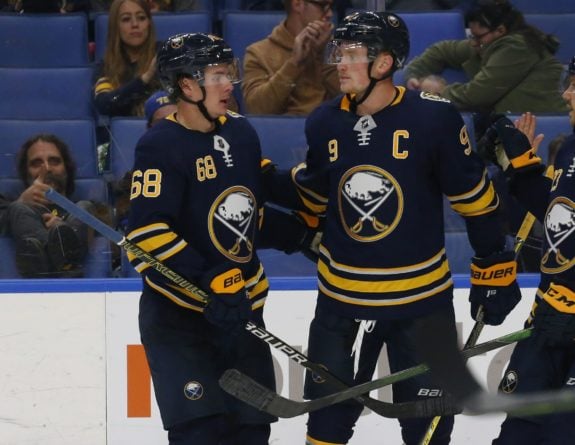
Evolving-Hockey helps paint a picture of the Sabres’ power play. Last season’s power play averaged 6.97 goals for, 1.06 goals against, 57.39 shots for and 95.05 shot attempts for per 60 min of play. Additionally, they had a shooting percentage of 12.15 percent and a .899 save percentage with an expected goals percentage of 90.61.
Related: NHL Power Rankings – March 2020
This season, the top-five power play contributors have changed. The most common unit has been Eichel, Reinhart, Dahlin, Olofsson and Ristolainen. Per 60, the man advantage has averaged 6.37 goals for, 1.3 goals against, 47.94 shots for and 87.91 shot attempts for. They have a 13.29 shooting percentage and a .882 save percentage with an 83.85 expected goals for percentage.
Those numbers back up what your eyes tell you. The Sabres are scoring less (.6 fewer goals per 60), allowing more goals (.24 per 60), shooting less (9.45 fewer per 60) and have few shot attempts (7.14 fewer per 60). With the skill they have on one unit, it makes sense that a greater percentage of their shots are going in. The fact that they are allowing 6.76 percent more expected goals against than last season is alarming.
Skinner Needs to Be on the Power Play
The one major change to the power play since last season is the personnel. Adding Olofsson to the number one unit is a no-brainer. Removing Skinner in favour of Ristolainen is a head-scratcher.
Although Skinner has traditionally made his living at five-on-five, his underlying numbers on the power play dictate that he should be used there. Adding him and swapping out Ristolainen would make a significant difference, it would add 5.46 shots per 60 and 5.41 shot attempts per 60.
True, Ristolainen can run the power play from the blue line. This season, though, head coach Ralph Krueger has mostly utilized him in a net-front role. He has the build to take the beating and create a screen in the crease, but he doesn’t possess the coordination to play the puck effectively in front. As a result, he averages the second-lowest shot rate on the team, ahead of Marcus Johansson who, let’s be honest, is afraid to shoot the breeze.
The unit has become predictable: their one plan is to get the puck to either Olofsson or Eichel on the half-wall for a bomb to the back of the net. This plan worked for the first six weeks of the season, but hey, so did Mike Babcock.
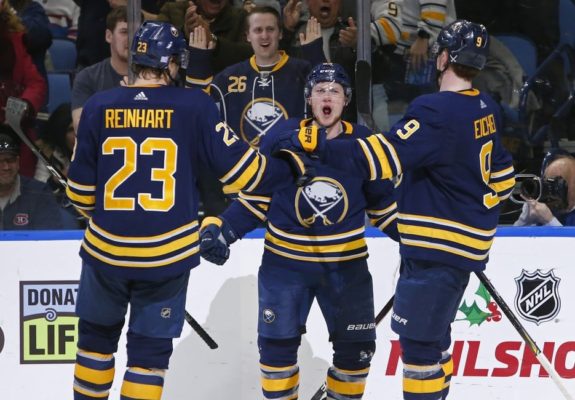
Opponents can defend against the Sabres’ man-advantage the same way every time now. They aggressively put pressure on the puck carrier and clog up the middle to negate a pass across. The Sabres then force the play leading to odd-man rushes the other way. They allow the 10th most expected goals against and have the 24th ranked save percentage with the extra man.
That is not a recipe for success. The Sabres have the players to make something of their power play. There is no reason they shouldn’t be a top-10 or even top-five team when up a man. The lack of creativity and the coaching plan are stifling the team’s talent.
If the Sabres can better utilize Skinner and get a little more innovative, they can have success. Don’t get me wrong, having Ristolainen in front was innovative. I love that they tried it. But the numbers don’t lie. Skinner has had a disappointing season but much of that comes from his lack of use on the power play. It’s time to place Reinhart in front with Skinner in the bumper position in the slot. Let Eichel and Olofsson work the puck down low and open up opportunities for Skinner and Dahlin back at the point.
The pieces are there. What they’ve been doing so far hasn’t worked. What do they have to lose?
Worst Penalty Kill Ever
I’m not kidding.
The Sabres’ 74 percent penalty kill percentage isn’t just the worst in the league it’s the worst in their 50-year history. If you thought the mid-2010s brought us the worst of everything, think again. Sure, the power play has been disappointing, but the penalty kill has cost them many valuable points this season.
Last season’s penalty kill was ranked a respectable 12th in the league with an 80.9 percent efficiency rate. The most heavily relied on four-man unit included Zach Bogosian, Zemgus Girgensons, Johan Larsson and Ristolainen. Per 60 min, the unit had a minus-6.5 goal differential, minus-44.53 shot differential, minus-80.73 shot attempt differential and minus-6.12 expected goal differential. They had a team shooting percentage of 5.66 percent and an .869 save percentage.
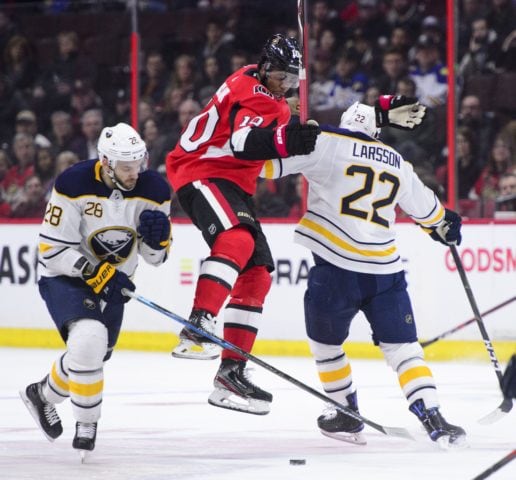
This season’s main unit has three of the four members from last season. The top-four are Ristolainen, Girgensons, Jake McCabe and Larsson. Compared to last season’s per-60 rates, this season is similar. They allow 1.29 more shots, 4.66 more shot attempts and .37 more expected goals. Of course, you always want to improve on these numbers, but the drop is not catastrophic.
What’s more interesting is the team has been stronger offensively on the penalty kill. They are shooting at a one percent higher success rate and have an expected goals for percentage nearly three percent higher than last season. In short, the quality of chances created when they are shorthanded is more in their favour this season.
None of these factors would make you think they could fall from being near the top-10 to a 50-year low in one season. Where does the most significant change occur?
Goaltending at the Root of Sabres’ Problems
The last line of defence, the Sabres’ goaltenders have a .838 save percentage, .03 lower than last season. A difference like that contributes to an extra 2.11 goals allowed per 60. Put in perspective, with 15 games remaining, they have already allowed four more goals on the penalty kill than last season.
Granted, the team is not absolved from all blame. The players tend not to pressure attackers and seem lost when the puck transitions from one side to the other. Defenders have failed to cover the right man and at times look lost out there. The reality is, though, that the bulk of the problem lies with the goaltending.
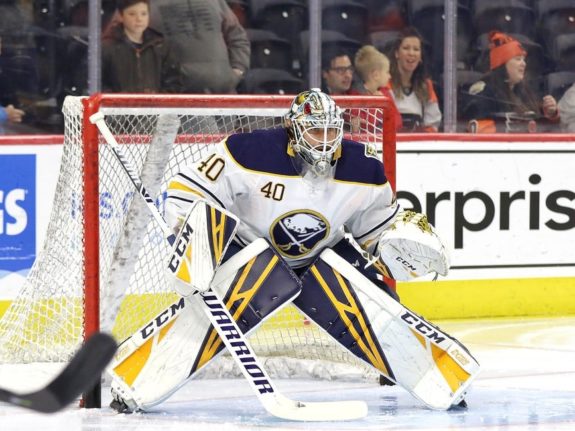
The Sabres allowed 40.32 expected goals last season and 42 actual goals. The goaltending allowed almost two more goals than they would be expected to based on the quality of chances they faced. This season, the team has allowed 35.26 expected goals and 46 actual goals. Their goalies have allowed roughly 11 more goals than they should have based on the quality of chances they have faced.
Last season’s shorthanded unit allowed the seventh-fewest expected goals against and had the 11th ranked save percentage. Pretty solid. This season, they’ve allowed the 11th fewest expected goals against but have the 30th ranked save percentage.
It’s demoralizing, and it’s changing the way they play.
The Sabres know they can’t afford to take penalties. On a per-game basis, they are taking fewer penalties than last season. Normally, a team can have a degree of confidence in their ability to kill off a penalty and can thus defend a little more aggressively and take more chances.
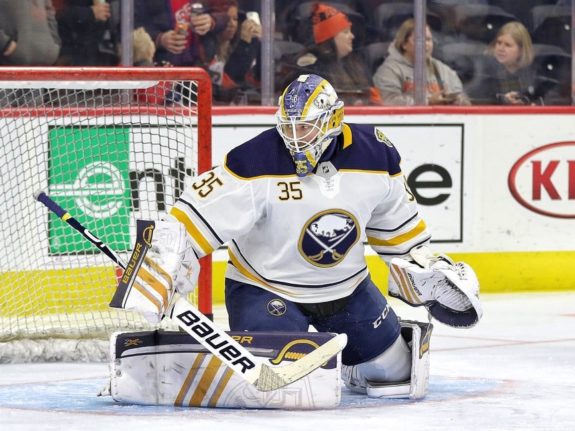
This team simply can’t do that. They can’t defend aggressively nor can they afford to take risks for fear they should be penalized. They have about as much confidence in their unit as you and I have in their playoff chances.
Short of changing personnel in net and the coaching behind the bench, there is very little that can be done about this now. The season is shot. In 2020-21, changes have to be made to the coaching staff and to the team’s goaltenders. They cannot trot out the same product next year and hope for different results. Right?
Sabres Need Changes Top to Bottom
This comes down to more than just special teams. The Sabres don’t have the right players playing the right way or getting instructions from the right people. They need to make changes. Alert the press.
The Sabres should have an elite power play. Eichel’s skill and creativity make it so. Add Olofsson’s bomb of a shot on top of Dahlin’s wizardry running the point and you have the makings of something special.
The team is generally low-event. They don’t allow much but they also don’t create much. On the penalty kill, the Sabres tend to be more high-event, but are still not much different from last season. The main difference is in goal. Sure, the team can tighten up some coverage and perhaps look at attacking teams more aggressively but not before changes are made.
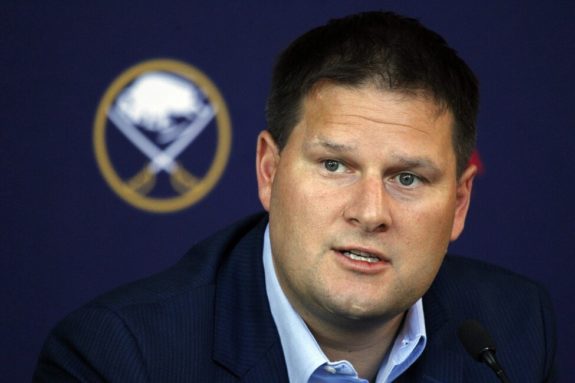
The good news is, many options to improve are already in-house. The bad news is that changes should be made to who is making the calls. The worse news is, changes need to be made to whoever put those people in charge of making those calls.
In short, the Sabres need top-to-bottom changes within the organization. Missing the playoffs for a ninth straight season and third of this regime is inexcusable. Many no longer find the team to be of any consequence in their lives and that is the worst possible news for a sports organization.
The special teams, while not everything are a microcosm of the organization over the last decade. They are disorganized, predictable and not utilized properly. Fans are clamouring for change and Terry and Kim Pegula need to listen. Otherwise, they will alienate an impassioned alliance of followers.
You could say the fans want to feel a little more “special”.